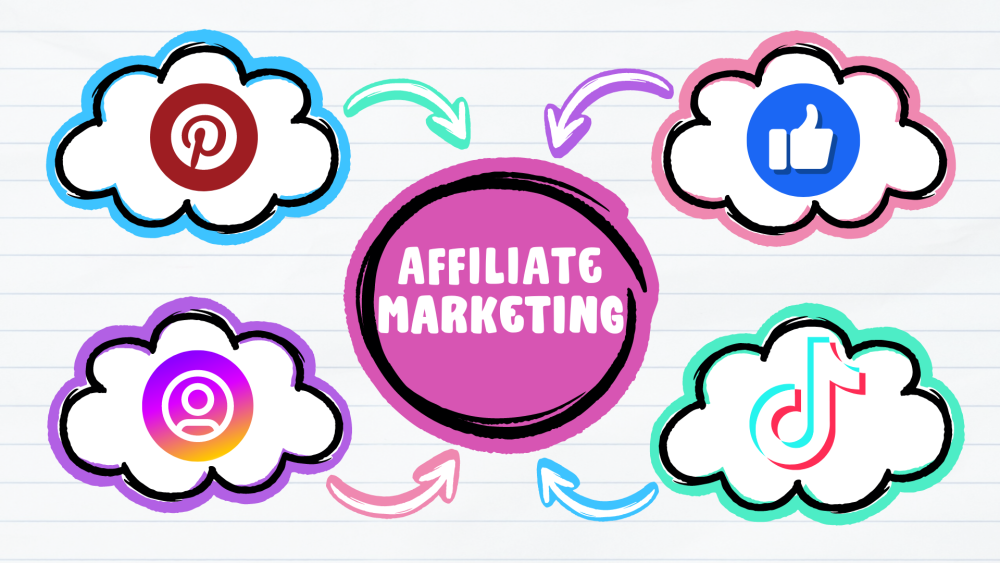
First, let’s take a look at how the land lies with affiliate marketing on social media. For many users, social media is nothing more than sharing life updates or trendy memes. But for affiliate marketers, it is so much more.
It’s not too dramatic to call it a battleground, seemingly with all and sundry attempting to have their voices heard. It’s the place where you get to shine by connecting the right people with products they’ll love.
I’m going to run through the importance of keeping your affiliate marketing strategies up to date as social media platforms introduce new features and trends take off. For example, you need to be ready to leverage things like Instagram’s shoppable posts or TikTok challenges as they become popular.
Choosing the right platform can make or break your affiliate success – there are so many of them, that it can feel like a daunting task. For example, for those targeting a tech-savvy audience, GitHub is used for collaboration on software development projects, sharing code, and contributing to open-source projects.
Its features – primarily, GitHub Pages, GitHub Actions, and collaboration tools like pull requests and issues – allow affiliate marketers to easily host static landing pages and websites directly from their repositories; to automate workflows; and facilitate teamwork by allowing marketers to propose changes, review code, and track tasks.
Case Studies
Here are two case studies where affiliate marketers have successfully leveraged social media campaigns to achieve significant boosts in sales and visibility:
Neil Patel’s Social Media Marketing Success
Neil Patel, a renowned digital marketer and co-founder of Crazy Egg and Hello Bar, utilized social media marketing to drive affiliate sales effectively. His innovative approach combined strategic content creation and targeted social media advertising. He also leveraged his considerable personal brand to build trust and engagement.
In terms of content creation, Patel focused on creating high-quality, informative content that addressed the pain points of his target audience. This content was shared across various social media platforms to attract and engage followers.
He then targeted social media ads to reach specific demographics that were more likely to convert. This included using Facebook and Instagram ads to promote affiliate products.
Patel leveraged his established personal brand, therefore building trust with his audience. This then made them more likely to click on his affiliate links and make purchases.
As a result of this strategy, Patel’s visibility and engagement on social media platforms were enhanced. Consequently, he saw a significant increase in affiliate sales. He also oversaw the establishment of a virtuous circle as he saw his personal brand strengthened, which in turn led to long-term benefits beyond the immediate sales.
To read more, check out this article on Medium.com, Affiliate marketing case studies: Success Stories and Strategies for Inspiration
Helping Choose Wheels Grow 124% – Intergrowth Affiliate Marketing Case Study
The website Choose Wheels provides comprehensive guides on personal transportation devices (electric scooters, electric bikes, and much more). In essence, their business model is to build partnerships with companies selling such devices. When they help to make a sale, they collect a portion of the revenue generated.
They suffered from a Google penalty and Intergrowth helped them recover and grow its traffic and sales to a higher level than was previously the case. This was done through a comprehensive affiliate marketing strategy which included a strong focus on social media.
Their strategy was three-pronged. First, they increased social media engagement by regularly posting valuable content related to wheels and automotive accessories. This included product reviews, how-to guides, and user-generated content.
Obviously, this required enhanced content, so they optimized existing content and created new, SEO-friendly content that they shared on social media to attract organic traffic.
Then they partnered with influencers in the automotive niche to promote their affiliate products. These influencers shared their experiences and reviews on social media, driving traffic and sales.
As a result, traffic grew by 124% in six months and the bounce rate improved by 15%. Average session duration increased by 40% and goal conversions increased by a whopping 526%, which led to a substantial boost in affiliate sales.
For a deeper insight, read Affiliate Marketing Case Study: Helping Choose Wheels Grow 124%.
Both these case studies highlight the power of strategic social media marketing in driving affiliate sales and increasing visibility. They show that for affiliate marketers to achieve significant success in their campaigns, we should focus on high-quality content, targeted advertising, influencer partnerships, and leveraging personal branding.
Crafting Your Unique Affiliate Voice and Brand
A branded tone and aesthetic that’s unmistakably yours is essential. In the world of social media, having this unique voice and brand is key to your message standing out in a crowded marketplace.
When it comes to your brand, it must fit with what you are offering, and it must appeal to your target audience. Then, there’s consistency. Your social media posts, stories, and even the way you respond to comments should all align with your brand voice. This consistency helps to build recognition and trust with your followers, turning them from casual viewers into loyal fans.
Running concurrently with your branding goals is the need to build and maintain authenticity. Ultimately, this is the key to your making sales. This may sound counterintuitive, but to achieve that, you need to create a narrative that’s not just about selling products. More important, especially in the long term, is sharing your and other’s journeys and experiences which relate to your affiliate offerings.

It’s the feel, felt, found technique. You show your customers that you understand how they feel, perhaps others felt the same way. Then you describe what they found when they used or experienced your solution.
Although this is a commonly used sales technique, you are not applying it explicitly. You are creating a narrative which is subconsciously suggestive of it.
By crafting your narrative in this way, you forge a real connection with your social media audience. Then, when they are exposed to your recommendations, they’re more likely to trust you and act.
Which brings us to integrating your affiliate products. With the right approach, you can showcase products naturally within your content. This might look like product reviews, tutorials, or sharing personal stories about how the product fits into your life. Remember, the goal is to provide value to your followers; if you manage that, the sales will follow.
Building and Engaging Your Community for Affiliate Success
Engagement is the heart of social media. As an affiliate marketer, it’s your lifeline. A vibrant, interactive community can boost your affiliate endeavours exponentially. Here are some suggested steps to create and nurture a community that trusts and supports your recommendations.
First, remember that your followers are not just numbers. You are aiming to help real people who are looking for valuable content. So, offer them insights, share tips, or talk about real issues tied to the products you’re promoting.
This is not just about highlighting a product; it’s about providing solutions. Google and other search engines expect this too. Even though you may be using a social media platform with millions of followers and page views, your posts will be hard to locate if you’re not giving people what they want.
Now, let’s talk about interactivity. Use features like polls, quizzes, and live streams. Think. If your audience actively participates, they feel engaged; they feel part of your community, they belong. The benefit you gain is that they’re a great chance to showcase products naturally while fielding questions and getting direct feedback.
Remember, encouraging your community to share their own content can do wonders. Customers posting about their positive experiences with the products you endorse adds to your aura of authenticity and trust. Potential buyers relate instantly.
Of course, nothing comes easy. Building such a community takes time, but it’s the mark of a sustainable affiliate strategy. Next, we’ll look at how to measure the success of your social strategies and how to scale them up.
Measuring Success and Scaling Your Affiliate Efforts
In the world of affiliate marketing, it’s not just about putting links out there and hoping for the best. You’re going to find out about the importance of tracking your efforts and making informed decisions to grow your strategy.

Key performance indicators (KPIs) are your compass in the affiliate marketing terrain. I’m now going to briefly introduce some of these and give you a flavour of their importance. Such indicators will help you understand what’s working and what’s not.
With that said, these are a selection of KPIs that directly measure the effectiveness of your campaigns and their impact on your affiliate marketing goals.
Click-Through Rate (CTR)
This is defined as the percentage of people who click on your affiliate links, as compared to the number of people who view your content. A high CTR indicates that your content is engaging and compelling enough to drive traffic to the affiliate offers.
Conversion Rate
Your conversion rate is the percentage of visitors who complete a desired action (e.g., making a purchase) after clicking on your affiliate link. It shows how effective your social media content is at driving actual sales or leads.
Affiliate Revenue
This may sound obvious, but affiliate revenue is the total income generated from affiliate sales through your social media channels. Even more obviously, it directly measures the financial success of your affiliate marketing efforts – it is the bottom line of your efforts.
Engagement Rate
This one is related to your social media accounts and is the level of interaction (likes, comments, shares) your content receives relative to your follower count. Its importance cannot be overstated. A high engagement rate may lead to increased visibility and trust, which can drive more affiliate link clicks and conversions.
Reach and Impressions
These are, respectively, the number of unique users who see your content, and the total number of times your content is displayed, regardless of whether it is clicked or not. Both help you understand the potential audience size and the frequency with which your content is viewed.
Return on Investment (ROI)
Related to your affiliate revenue, this measure is calculated by dividing that revenue by the cost of your social media campaigns. It is a measure of the overall profitability of your affiliate marketing efforts.
Referral Traffic
This does exactly what it says on the tin and is the amount of traffic your website receives from social media platforms. It is important because it indicates how effectively your social media channels drive visitors to your site, where they can be converted into customers.
Customer Lifetime Value (CLV)
CLV is the total revenue expected from a customer throughout their relationship with your brand. It can be measured by estimating the revenue a customer will generate over their entire relationship with your business. It helps you to understand the long-term value of customers acquired through social media affiliate marketing.
Bounce Rate
This is the percentage of visitors who leave your site after viewing only one page. Obviously, as low a bounce rate as possible is desirable. A high bounce rate probably indicates that your landing page or content is not relevant or engaging enough for visitors coming from social media – or, for that matter, anywhere else.

Social Media Sentiment
This is measured as the overall sentiment (positive, negative, neutral) of the comments and interactions on your social media posts. It is useful because it provides insights into how your audience perceives your content and brand, which can impact affiliate marketing success.
However, it is a somewhat nebulous concept due to its subjective and complex nature. That said, it can still afford a modicum of understanding public perception and therefore guide decision-making.
Cost Per Acquisition (CPA)
CPA is the cost of acquiring a new customer through your affiliate marketing efforts. It helps you measure the efficiency of your spending on social media campaigns.
Affiliate Link Performance
These are a range of metrics specific to the performance of individual affiliate links. They include, but are not limited to, clicks, conversions, and revenue generated. They are important because they allow you to identify which links and products perform best, and optimize your strategy accordingly.
By regularly monitoring these KPIs, you can gain valuable insights into the effectiveness of your social media affiliate marketing efforts and make data-driven decisions to optimise your strategy.
And Finally
As we approach the end of this article, I’d like briefly to touch on A/B testing. This is a not-so-secret weapon with great potential for social media success. Making simple tweaks to your posts may result in big changes in engagement and conversion. This is so much more than merely changing colours. It’s about fine-tuning your message to see how your audience responds.
As your affiliate success gains momentum, you might be tempted to stick to one winning formula. Whilst that’s a perfectly valid strategy, I would also suggest you keep your eyes and ears open for opportunities to expand your horizons. The next new thing in social media may afford you even greater scope. So too will affiliating with additional products or services when the time is right.
There you have it, a strategy for using social media to aid you in your affiliate marketing endeavours. I hope that you can take these insights and apply them to your social media strategy for affiliate marketing. The landscape is rich with opportunity, and with the right tools and tactics, you’re well on your way to success.
Remember, your first attempt is unlikely to be your final effort. Constant performance monitoring will allow you to refine, enhance, and scale your efforts as you go.

